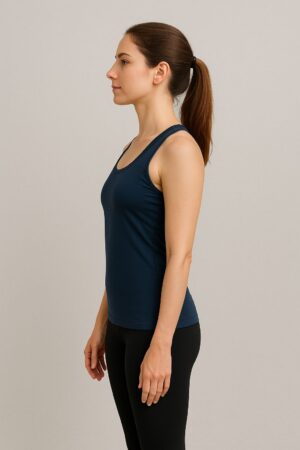Growing up, my Grandma Barbara was one of my favorite people. She lived right next door in a guest apartment, and every afternoon when I came home from school, she was there to greet me. If I walked in with a bit of a slouch—maybe from lugging around a heavy backpack all day—she’d call out, “Stand up straight! Pull your shoulder blades down and back!”
I know she meant well, and I bet you’ve heard similar advice from someone in your life too.
But here’s the thing: as much as I hate to say it, Grandma was wrong.
Why “Shoulder Blades Down and Back” Can Do More Harm Than Good
In physical therapy, we see a lot of people who have been told to constantly brace their shoulder blades down and back to “fix” their posture. While that advice might sound helpful, it often causes more problems than it solves.
The reality is that posture isn’t about locking your body into one rigid position. Slouching often happens because we’re tired or trying to conserve energy—not because our shoulder blades are out of alignment. Trying to force them into place just adds unnecessary tension and restricts healthy movement.
In our physical therapy clinics in Bethesda and McLean, we frequently help active adults correct these habits so they can move better, perform stronger, and live pain-free.
Your Shoulder Blades Were Built to Move
In sport, fitness, and life, your arms need freedom to move—whether you’re lifting weights, throwing a ball, or reaching overhead. Your shoulder blades are designed to support that movement by gliding up and out—not staying pinned back.
As physical therapists, we help patients retrain how their shoulder blades move with their body instead of against it. This improves posture, relieves shoulder pain, and supports stronger performance in the gym or everyday life.
3 Physical Therapy Exercises to Improve Posture and Shoulder Function
These are three of the most effective drills we use at Cohen Health and Performance to teach better posture, improve shoulder control, and support strong, pain-free movement.
1. Core Push-Up with Serratus Activation
Most people perform push-ups with their shoulder blades pulled back and their chest puffed out—but that’s not how your body naturally moves.
In physical therapy, we coach patients to reach their chest away from the floor to activate the serratus anterior. This helps stabilize the shoulder blades in a healthy position.
2. Overhead Press with Scapular Movement
Rather than bracing the shoulder blades, we encourage our patients to let them rotate upward naturally during pressing movements. This protects the shoulder joint and mimics how your body moves in real-life tasks and athletic performance.
3. Dumbbell Pullover for Trunk Positioning
This simple but powerful drill reinforces good trunk posture while allowing natural shoulder motion. We often include this exercise in warm-ups or between sets as part of a customized physical therapy or training plan.
Rethink Posture: A Better Cue
Instead of constantly thinking “shoulder blades down and back,” try this:
Imagine a string gently pulling you up from the top of your head.
This subtle cue can reorient your posture without adding tension or compromising your shoulder mobility.
And here’s the kicker—perfect posture isn’t the goal. At Cohen Health and Performance, our physical therapy team focuses on helping you move efficiently, stay strong, and avoid injury—because those things are what actually matter.
Physical Therapy Can Help You Move Better—Not Just Stand Straighter
If you’re struggling with shoulder pain, poor posture, or feeling like your workouts are hitting a wall, we’re here to help. Our physical therapy approach is personalized, movement-based, and designed for athletes and active adults who want to keep doing what they love—without pain or limitations.
Book an appointment here at our Bethesda or McLean location to get started.
